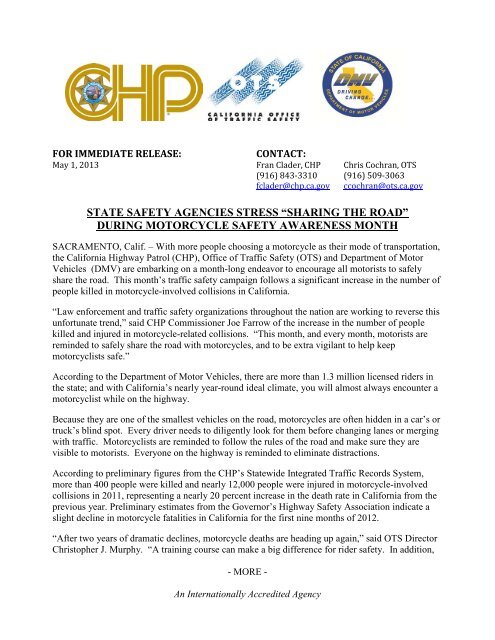Motorcycle Safety Awareness Month - California Department of ...
Motorcycle Safety Awareness Month - California Department of ...
Motorcycle Safety Awareness Month - California Department of ...
Create successful ePaper yourself
Turn your PDF publications into a flip-book with our unique Google optimized e-Paper software.
FOR IMMEDIATE RELEASE:<br />
CONTACT:<br />
May 1, 2013 Fran Clader, CHP Chris Cochran, OTS<br />
(916) 843-3310 (916) 509-3063<br />
fclader@chp.ca.gov ccochran@ots.ca.gov<br />
STATE SAFETY AGENCIES STRESS “SHARING THE ROAD”<br />
DURING MOTORCYCLE SAFETY AWARENESS MONTH<br />
SACRAMENTO, Calif. – With more people choosing a motorcycle as their mode <strong>of</strong> transportation,<br />
the <strong>California</strong> Highway Patrol (CHP), Office <strong>of</strong> Traffic <strong>Safety</strong> (OTS) and <strong>Department</strong> <strong>of</strong> Motor<br />
Vehicles (DMV) are embarking on a month-long endeavor to encourage all motorists to safely<br />
share the road. This month’s traffic safety campaign follows a significant increase in the number <strong>of</strong><br />
people killed in motorcycle-involved collisions in <strong>California</strong>.<br />
“Law enforcement and traffic safety organizations throughout the nation are working to reverse this<br />
unfortunate trend,” said CHP Commissioner Joe Farrow <strong>of</strong> the increase in the number <strong>of</strong> people<br />
killed and injured in motorcycle-related collisions. “This month, and every month, motorists are<br />
reminded to safely share the road with motorcycles, and to be extra vigilant to help keep<br />
motorcyclists safe.”<br />
According to the <strong>Department</strong> <strong>of</strong> Motor Vehicles, there are more than 1.3 million licensed riders in<br />
the state; and with <strong>California</strong>’s nearly year-round ideal climate, you will almost always encounter a<br />
motorcyclist while on the highway.<br />
Because they are one <strong>of</strong> the smallest vehicles on the road, motorcycles are <strong>of</strong>ten hidden in a car’s or<br />
truck’s blind spot. Every driver needs to diligently look for them before changing lanes or merging<br />
with traffic. Motorcyclists are reminded to follow the rules <strong>of</strong> the road and make sure they are<br />
visible to motorists. Everyone on the highway is reminded to eliminate distractions.<br />
According to preliminary figures from the CHP’s Statewide Integrated Traffic Records System,<br />
more than 400 people were killed and nearly 12,000 people were injured in motorcycle-involved<br />
collisions in 2011, representing a nearly 20 percent increase in the death rate in <strong>California</strong> from the<br />
previous year. Preliminary estimates from the Governor’s Highway <strong>Safety</strong> Association indicate a<br />
slight decline in motorcycle fatalities in <strong>California</strong> for the first nine months <strong>of</strong> 2012.<br />
“After two years <strong>of</strong> dramatic declines, motorcycle deaths are heading up again,” said OTS Director<br />
Christopher J. Murphy. “A training course can make a big difference for rider safety. In addition,<br />
- MORE -<br />
An Internationally Accredited Agency
2-2-2-2<br />
much can be accomplished when both riders and motorists share the road safely and watch out for<br />
each other.”<br />
The CHP administers <strong>California</strong>'s <strong>of</strong>ficial safety training program for motorcyclists through the<br />
<strong>California</strong> Motorcyclist <strong>Safety</strong> Program (CMSP). As <strong>of</strong> March 2012, more than 800,000<br />
motorcycle riders have received training at one <strong>of</strong> the CMSP's 134 training sites since the program<br />
began in July 1987.<br />
The <strong>Motorcycle</strong> <strong>Safety</strong> Foundation (MSF), a national non-pr<strong>of</strong>it organization, is charged with<br />
overseeing the day-to-day operations for the CMSP. The MSF not only emphasizes the importance<br />
<strong>of</strong> training and licensing for all motorcyclists, but stresses a rider’s critical need for proper safety<br />
gear.<br />
“Not only should motorcyclists wear protective gear, all <strong>of</strong> the time, including a helmet<br />
manufactured to the standards set by the U.S. <strong>Department</strong> <strong>of</strong> Transportation; they should ride<br />
unimpaired by alcohol or drugs,” said MSF Vice President Robert Gladden. “If you follow these<br />
simple steps, lives can be saved.”<br />
The CHP, DMV and OTS <strong>of</strong>fer the following tips for drivers to help keep motorcyclists safe on our<br />
roadways:<br />
• Remember, a motorcycle is a vehicle with all <strong>of</strong> the rights and privileges <strong>of</strong> any other motor<br />
vehicle. The person under that helmet could be a mother, brother, doctor, or friend.<br />
• Perform a regular visual check for motorcycles by checking mirrors and blind spots before<br />
entering or exiting a lane <strong>of</strong> traffic, at intersections, and pulling out <strong>of</strong> driveways and<br />
parking lots. Always look twice before pulling out.<br />
• Always signal your intentions before changing lanes or merging with traffic.<br />
• Don’t be fooled by a flashing turn signal on a motorcycle – motorcycle signals are <strong>of</strong>ten not<br />
self-canceling. Wait to be sure the motorcycle is going to turn before you proceed.<br />
• Allow more following distance - three or four seconds - when behind a motorcycle to give<br />
the motorcyclist time to maneuver around obstacles in the roadway or stop in an emergency.<br />
Motorcyclists can increase their safety by:<br />
• Wearing a DOT-compliant helmet.<br />
• Never riding while impaired.<br />
• Using turn signals for every turn or lane change, even if the rider thinks no one will see it.<br />
• Signaling intentions by combining hand signals and turn signals to draw more attention to<br />
themselves.<br />
• Assuming drivers can’t see them. Wearing brightly colored protective gear and using<br />
reflective tape and stickers to make sure they are seen.<br />
• Positioning themselves in the lane where they will be most visible to other drivers.<br />
• Not accelerating too quickly, since drivers turning ahead might not notice until too late.<br />
•<br />
The CHP, DMV and OTS join with the National Highway Traffic <strong>Safety</strong> Administration in sharing<br />
the following message: Help share in the responsibility <strong>of</strong> keeping all road users safe, and do your<br />
part by safely “sharing the road.”<br />
# # # #<br />
An Internationally Accredited Agency
















